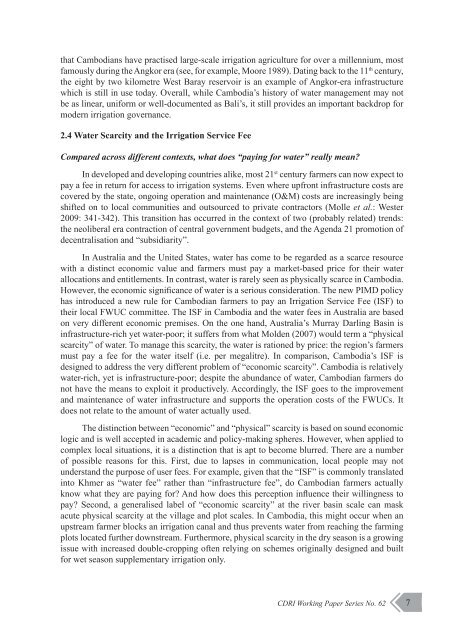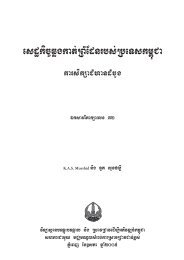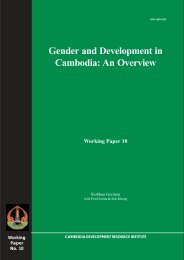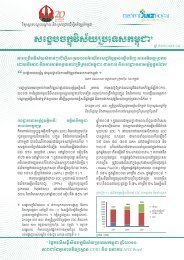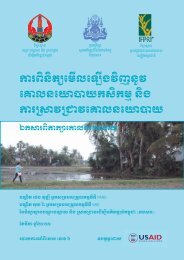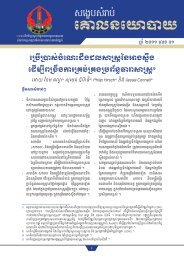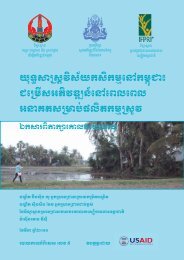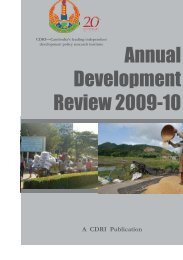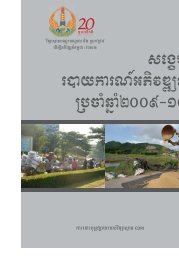62) decentralised governance of irrigation water in cambodia - CDRI
62) decentralised governance of irrigation water in cambodia - CDRI
62) decentralised governance of irrigation water in cambodia - CDRI
You also want an ePaper? Increase the reach of your titles
YUMPU automatically turns print PDFs into web optimized ePapers that Google loves.
that Cambodians have practised large-scale <strong>irrigation</strong> agriculture for over a millennium, most<br />
famously dur<strong>in</strong>g the Angkor era (see, for example, Moore 1989). Dat<strong>in</strong>g back to the 11 th century,<br />
the eight by two kilometre West Baray reservoir is an example <strong>of</strong> Angkor-era <strong>in</strong>frastructure<br />
which is still <strong>in</strong> use today. Overall, while Cambodia’s history <strong>of</strong> <strong>water</strong> management may not<br />
be as l<strong>in</strong>ear, uniform or well-documented as Bali’s, it still provides an important backdrop for<br />
modern <strong>irrigation</strong> <strong>governance</strong>.<br />
2.4 Water Scarcity and the Irrigation Service Fee<br />
Compared across different contexts, what does “pay<strong>in</strong>g for <strong>water</strong>” really mean?<br />
In developed and develop<strong>in</strong>g countries alike, most 21 st century farmers can now expect to<br />
pay a fee <strong>in</strong> return for access to <strong>irrigation</strong> systems. Even where upfront <strong>in</strong>frastructure costs are<br />
covered by the state, ongo<strong>in</strong>g operation and ma<strong>in</strong>tenance (O&M) costs are <strong>in</strong>creas<strong>in</strong>gly be<strong>in</strong>g<br />
shifted on to local communities and outsourced to private contractors (Molle et al.: Wester<br />
2009: 341-342). This transition has occurred <strong>in</strong> the context <strong>of</strong> two (probably related) trends:<br />
the neoliberal era contraction <strong>of</strong> central government budgets, and the Agenda 21 promotion <strong>of</strong><br />
decentralisation and “subsidiarity”.<br />
In Australia and the United States, <strong>water</strong> has come to be regarded as a scarce resource<br />
with a dist<strong>in</strong>ct economic value and farmers must pay a market-based price for their <strong>water</strong><br />
allocations and entitlements. In contrast, <strong>water</strong> is rarely seen as physically scarce <strong>in</strong> Cambodia.<br />
However, the economic significance <strong>of</strong> <strong>water</strong> is a serious consideration. The new PIMD policy<br />
has <strong>in</strong>troduced a new rule for Cambodian farmers to pay an Irrigation Service Fee (ISF) to<br />
their local FWUC committee. The ISF <strong>in</strong> Cambodia and the <strong>water</strong> fees <strong>in</strong> Australia are based<br />
on very different economic premises. On the one hand, Australia’s Murray Darl<strong>in</strong>g Bas<strong>in</strong> is<br />
<strong>in</strong>frastructure-rich yet <strong>water</strong>-poor; it suffers from what Molden (2007) would term a “physical<br />
scarcity” <strong>of</strong> <strong>water</strong>. To manage this scarcity, the <strong>water</strong> is rationed by price: the region’s farmers<br />
must pay a fee for the <strong>water</strong> itself (i.e. per megalitre). In comparison, Cambodia’s ISF is<br />
designed to address the very different problem <strong>of</strong> “economic scarcity”. Cambodia is relatively<br />
<strong>water</strong>-rich, yet is <strong>in</strong>frastructure-poor; despite the abundance <strong>of</strong> <strong>water</strong>, Cambodian farmers do<br />
not have the means to exploit it productively. Accord<strong>in</strong>gly, the ISF goes to the improvement<br />
and ma<strong>in</strong>tenance <strong>of</strong> <strong>water</strong> <strong>in</strong>frastructure and supports the operation costs <strong>of</strong> the FWUCs. It<br />
does not relate to the amount <strong>of</strong> <strong>water</strong> actually used.<br />
The dist<strong>in</strong>ction between “economic” and “physical” scarcity is based on sound economic<br />
logic and is well accepted <strong>in</strong> academic and policy-mak<strong>in</strong>g spheres. However, when applied to<br />
complex local situations, it is a dist<strong>in</strong>ction that is apt to become blurred. There are a number<br />
<strong>of</strong> possible reasons for this. First, due to lapses <strong>in</strong> communication, local people may not<br />
understand the purpose <strong>of</strong> user fees. For example, given that the “ISF” is commonly translated<br />
<strong>in</strong>to Khmer as “<strong>water</strong> fee” rather than “<strong>in</strong>frastructure fee”, do Cambodian farmers actually<br />
know what they are pay<strong>in</strong>g for? And how does this perception <strong>in</strong>fluence their will<strong>in</strong>gness to<br />
pay? Second, a generalised label <strong>of</strong> “economic scarcity” at the river bas<strong>in</strong> scale can mask<br />
acute physical scarcity at the village and plot scales. In Cambodia, this might occur when an<br />
upstream farmer blocks an <strong>irrigation</strong> canal and thus prevents <strong>water</strong> from reach<strong>in</strong>g the farm<strong>in</strong>g<br />
plots located further downstream. Furthermore, physical scarcity <strong>in</strong> the dry season is a grow<strong>in</strong>g<br />
issue with <strong>in</strong>creased double-cropp<strong>in</strong>g <strong>of</strong>ten rely<strong>in</strong>g on schemes orig<strong>in</strong>ally designed and built<br />
for wet season supplementary <strong>irrigation</strong> only.<br />
<strong>CDRI</strong> Work<strong>in</strong>g Paper Series No. <strong>62</strong><br />
7


